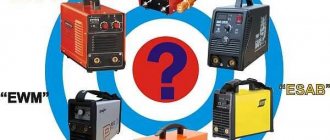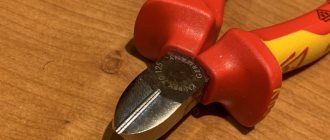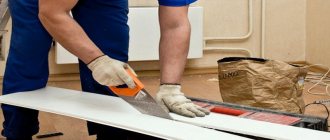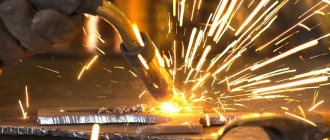- 1 Selecting a tool and working with it
- 2 Surface preparation
- 3 Drill selection
- 4 A little about the design of the drill and installation of the drill
- 5 Selection of power for drills
- 6 Mistakes when working with a drill
- 7 Some useful tips
Each of us has repeatedly faced the need to mount various objects on the walls that add variety to the interior, create comfort, or simply remind us of the pleasant moments of life. Most often you have to attach lamps and sconces, paintings and photographs, mirrors and shelves to a concrete surface, install an air conditioner, or a TV. If in the case of a small painting or photograph you can get by by driving a nail into the wall, then when the question is about more massive and heavy objects, the question of drilling holes arises. To avoid misunderstandings when working with concrete, for example, drill breakage or dullness, it is worth properly preparing the partition, choosing a high-quality tool and selecting the correct drill.
Choosing a tool and working with it
When choosing a tool to drill a hole, you should understand that your work depends on it. A good drill accurately drills into a concrete wall or other required material, simplifying the drilling process, while a bad one will require a lot of time, may not cope with the task, or will complicate it. What you need to pay attention to when choosing a drill:
- Is it possible to change the drilling speed? – this point is important, since correction of the speed mode will ensure accurate operation of the drill, helping it not to damage the surface.
- Is it possible to hammer drill and adjust the depth? – impact drilling can be used on problem areas, softening them.
- Is it possible to hold the drill with both hands? – a drill is not a light tool and therefore preference should be given to models that are equipped with handles.
- Is the tool's power sufficient for your job?
Having decided on a drill, before starting work you need to get the hang of holding it. To do this, you should take the drill in one hand, like a pistol, and place the other hand on the handle of the tool (if it is not intended by the design, the hand is placed near the chuck). It is necessary to hold the drill in your hands strictly horizontally, so that the hole does not turn out distorted or at the wrong angle. Wait until the drill reaches ambient temperature before turning on the drill. Sudden temperature changes can cause condensation. If you decide to rest while working, unplug the tool.
Return to contents
How to drill a brick wall
Drilling brick with a drill is a simple process. An impact drill is used for work. If drilling is unstressed, the drilling process may take a long time. It is very important that the tool operates at high power. Quantitative indicators of revolutions per minute are also important. Indicators of more than 2,000 revolutions are considered the most acceptable.
Of course, to perform better work, a hammer drill is used. If it is not at hand, then use high-power drills. To drill a hole you do not need any special knowledge. The main thing is to follow a number of simple recommendations mentioned above. Sometimes you can stumble upon a burnt stone. It will be quite difficult to form a cavity in it. Such a brick is identified by the dust generated during operation. It becomes a pronounced black shade.
To create holes in burnt rocks, you need to turn on the drill at low speeds and set the impact function. You need to press very hard on the tool for the impact function to work correctly. It is also important to ensure that the drill does not overheat during operation. A severely overheated drill causes the edges of the drill to wear out quickly. For such purposes, a diamond-coated drill is most often used. This way the clutch is most effective. This leads to significant savings in physical effort and energy.
Sometimes situations arise when the hole made needs to be made of a significant diameter. For example, this could be a ventilation outlet. Such work will be very difficult to organize with ordinary tools. You will need powerful equipment and large crowns.
Surface preparation
It must be remembered that the wall is looser than the following layers.
Before you start drilling, you need to make sure that there are no wiring, pipes, or electrical cables in the selected area of the ceiling. A metal detector will help you cope with this task, as it reacts to non-ferrous metals, iron and steel.
If you ignore this condition, you may stumble upon the fittings, damage the drill, or cables/pipes that were hidden in the ceiling. If this area satisfies all the above requirements, then a point is marked on the wall, and then a small indentation is made in it at slow speed using a drill. It is also worth remembering that the surface of a concrete wall is looser than subsequent layers.
Return to contents
You've almost drilled to the required depth and you can't go any further.
Almost - this means, for example, for a depth of 5 cm you underdrilled 5 mm.
Then you hit something. There are rare cases when you come up against something major, for example, some hard monolithic cobblestone that cannot really be drilled out or crushed in any way. If the self-tapping screw on which you are going to hang the structure does not have strict load requirements, then try taking the same self-tapping screw, but 5 mm shorter, and simply cut the dowel, which is not fully inserted into the hole and sticks out with a small end, with a construction knife. as shown in the picture:
Next, just take a self-tapping screw that is 5 mm shorter and screw it into the trimmed dowel. This is not a very good practice, but sometimes there are situations when nothing else can be done and then this is the way out!
Drill selection
This point can rightfully be considered the main one, since the quality of work and the safety of the drill itself, as well as the accuracy of the work, depend on the correctly selected drill. Today there is a huge variety of drills on the market: for working on wood, metal, concrete. The latter are distinguished by a triangular tip. For a concrete surface, it is best to use a carbide drill, such as a Pobedit one. This type of drill crushes the material without tearing it, which is ideal for concrete floors.
If, when drilling a wall, the drill does not go forward when it encounters a dense area, it is recommended to use a punch. Having inserted the punch into the hole, hit it with a hammer until it begins to move forward and softens the problem area. After this you can continue drilling.
It should be noted that without a punch, a hammer drill can easily cope with this kind of difficulty, but it makes holes that exceed 13 mm in diameter. If you want to use universal drills when drilling, you need to remember that they require cooling, vibration is turned off and are only suitable for a regular drill.
Return to contents
Drilling concrete
Necessary tool
Due to the nature of concrete, you will need a special tool to drill it:
- Hammer (impact drill) – provides rotational and translational movement of the drill.
- Concrete drills for impact drills, made of hard alloys. Their shank and screw part are made of tool steel, and the cutting working area is a plate of carbide metal sharpened at 60 degrees, which is sealed into the groove of the cutting part of the tool.
- Punch (needed when drilling with a conventional drill).
It must be said that it is possible to cope with the task with a tool without a striking function. Below we will take a closer look at how to drill through a concrete wall with a drill.
Carbide drill bits for concrete for drills
Drilling procedure with a hammer drill
The procedure for drilling a wall using a hammer drill and a special drill is quite simple:
- The concrete drill should be switched to hammer drilling mode and the operation should begin. The drill should be positioned strictly at an angle of 90 degrees with respect to the wall, unless drilling is specifically performed at a certain angle.
- After some time, the drill needs to be moistened in cold water and work continues.
- If the tool rests on something hard and stops going deeper, you will have to try to drill the wall in another place.
- Once the desired immersion depth has been reached, you should pull out the drill without turning off the drill. To clean the hole from dust, you need to deepen and pull out the drill several more times.
This completes the procedure.
Advice! A hammer drill can be used for more than just drilling hard materials. There are special attachments that turn this tool into a mixer. Thanks to them, a drill-mixer for concrete does an excellent job of stirring the solution.
Drilling
Many home craftsmen doubt whether it is possible to drill concrete with a drill? Of course, this procedure will take much longer than when working with a hammer drill, however, it is quite possible to make a hole.
To perform this operation you will need a special punch. This tool is a rod with a pointed hard end. It is used to break up the surface in the drilling area.
Instructions for performing this work are as follows:
- First of all, you need to place a punch at the place where the future hole will be located and hit it several times with a hammer.
- Then, a drill is inserted into the resulting funnel and a hole is drilled. As when working with a hammer drill, you need to ensure that the tool does not overheat.
- If the drill stops going deep, you need to use the punch again - insert it into the hole and hit it hard with a hammer several times.
- Drilling is carried out in this way until the desired hole depth is reached.
Advice! Often there is a need to cut concrete, in which case a grinder is used. However, it should be borne in mind that reinforced concrete is cut with diamond wheels.
As a result, although a conventional drill is not suitable for concrete, in the absence of a hammer drill, it can also be used to drill a reinforced concrete wall.
In the photo - working with a punch
Advice! A drill can be used not only to make holes, but also used for several other purposes. For example, on our portal you can learn how to make a vibrator for concrete with your own hands from a drill.
Diamond drilling
Finally, we need to talk about another effective drilling method that allows you to successfully make holes in walls. With its help, you can quickly cope with the task at hand without creating dust in the room. We are talking about diamond drilling. (See also the article Concrete dust removal: features.)
A little about the structure of the drill and installation of the drill
Drilling diagram for a concrete wall.
A classic drill consists of a power cable, a button, a capacitor wire, a reverse, brushes and springs, an armature, a stator, a gearbox and a chuck, bearings, a key and mounting screws. A correctly inserted drill improves the quality of drilling and can make it safer.
The first thing you should check when starting to work with a drill is whether there is any contamination on the drill itself. A rag will be an excellent assistant in cleaning drills. If the drill is loosely secured, there is a risk that it will fly out and injure the technician. Accordingly, it is necessary to immerse the drill as much as possible into the chuck (all the way!).
Under no circumstances try to “extend” the drill by incompletely immersing it in the chuck!
It is important to ensure that the drill in the tool is secured strictly along the axis. If this rule is not followed, drilling in concrete will be performed poorly, the shape of the hole may be unpredictable, and the cause of all these misunderstandings will be the elementary effect of drill beating.
Return to contents
Step-by-step instruction
How to make a hole in a concrete wall or ceiling slab without a hammer drill and other similar tools?
First you need to prepare everything.
Despite the presence of a special drill, work on a concrete wall is carried out taking into account the recommendations of specialists.
An incorrect approach can lead to tool breakage and partial destruction of the wall. Before starting work, prepare the following set of tools and materials:
- drill of sufficient power;
- drill with pobedite (carbide) surfacing;
- punch - a metal pin of the required diameter;
- hammer or sledgehammer;
- vacuum cleaner.
The process of drilling concrete with a conventional drill is not fast, so the home craftsman should be patient. Concrete dust eats into the floor covering, and to maintain cleanliness, it is recommended to cover the surface with newspapers. Periodically collect spilled particles with a vacuum cleaner. The sequence of work is as follows:
- An appropriate drill is installed on the tool. A drilling point is marked on the wall.
- Mark the drilling point, working at minimum speed, with light pressure. A small hole is made in the surface so that the drill does not slip during intensive actions.
- They go deep into the wall by 8-10 mm. The tool is held at a right angle while drilling. If misaligned, there is a risk of damage to the surface, tip or hands.
- Take out the drill and pierce the concrete with a steel rod.
- They go deeper into the wall another 10-15 mm and again finish off the concrete with a punch. After each stage of work, the drill is cleaned of concrete particles.
IMPORTANT. Each drilling stage should last no more than 30 seconds. The total duration of continuous drilling with a low-power tool is no more than 10-12 minutes. The motor of the tool must be cooled after each session, otherwise it will overheat and fail.
Drilling concrete with a diamond crown can be seen in the video:
In the video, the author explains how to drill concrete without impact:
Errors when working with a drill
Clothes and gloves must fit properly.
Under no circumstances should you try to hold the rotating chuck with your hand - this is what the drill body is for. Otherwise, you may injure yourself. If you use gloves, do not take them “with reserve”. Gloves that do not fit correctly may also become caught in the chuck and cause injury. Overalls should not hang loose - they can be rolled up or pressed with sleeves.- You should not press as hard as you can on the turned-on drill - this will cause you to fall, as it will become more difficult for you to control your balance. In addition, you may break the drill. If a tool passes through a concrete wall, the injuries it can cause to a person can be more than serious.
Return to contents
Video description
This video shows how to drill a hole with a diamond drill bit:
Diamond drilling is carried out in 2 ways - dry and wet. In the second case, when drilling, water constantly flows onto the working surface. It cools the drill and reduces noise; dust settles in it. However, if electrical wiring runs nearby or constant access to water is not possible, the dry method is used.
Diamond drilling produces smooth holes Source kas.kz
Some useful tips
- If a hole is being prepared for a plastic dowel, the hole should be drilled slightly larger than the length of the dowel itself, so that the dust remaining after work does not interfere with the correct placement of the dowel.
- It is correct to start drilling with low speeds - in this case, the drill will not jump on the surface, and when the hole reaches a sufficient depth, you can increase the speed, or switch the tool to impact mode.
- Over time, the chuck begins to hold the drills worse and in this case they need to be replaced. If you neglect this rule, the quality of work will be much lower, and you will also be putting yourself at risk.
- When drilling, do not forget to wet the drill with cold water - this will help protect it from breakage, and using special glasses will help you avoid concrete dust getting into your eyes.
- By placing a plastic cup on the drill, you will avoid such troubles as dust flying around the work surface, on your clothes, hair and face.
- If you work in accordance with the recommendations of the drill manufacturer, choose the right place to drill in the wall, do not make the mistakes listed above and follow safety precautions, then drilling a concrete wall will not be difficult for you.
The better to drill
As already mentioned, there are several ways to drill through a concrete wall; let’s look at each of them in more detail.
Hammer
When using a hammer drill or impact drill, they must be switched to impact mode, a working tool with a pobedite tip is inserted and it must be directed perpendicular to the wall surface.
If drilling holes takes a long time, then
periodically you need to wet the drill so that it does not overheat too much.
After you have drilled to the required depth, you must pull the working tool back without turning off the hammer drill . To clean the finished hole from dust, you need to deepen and pull out the drill several times.
A regular drill or screwdriver
If you do not have the tools described above, then this work can be done using a conventional electric drill or a powerful screwdriver.
Drilling will take more time than using a hammer drill, but you can do it yourself.
In this case, in addition to a drill and a drill bit, you will also need a punch . First, a small depression is made at the drilling site using a punch and a hammer.
After this, they insert the working tool into it and begin to drill. If the drill stops, break the hard areas again with a punch and continue working.
Diamond drilling
This is the most effective way to quickly and easily make a hole of the required diameter in a concrete wall.
To perform the above work, you will need special equipment consisting of the following elements:
- electric motor;
- a stand that is securely fixed to the base;
- core drill.
There is no need to cool the drill during operation, as water is supplied to it, which not only cools the tool, but also prevents dust from forming.
If specialists work, then together with the specified equipment they use a vacuum cleaner, with which they remove dust and water.
Since the price of such equipment is very high , it is not advisable to buy it for domestic use. If it is necessary to make a hole of a large diameter, you can always invite specialists for this.
Execution technology
We have dealt with the need and the difficulties that arise, now we will look at how to properly drill a concrete wall.
Tool selection
First of all, let's decide what to drill into a concrete wall. Drills for wood and concrete, of course, are not suitable.
You can choose from the following options:
Drills tipped from Pobedit. But it should be borne in mind that in addition to rotation, a shock function will also be required.
Pobedite product
Diamond product
But the question of how to drill into a concrete wall is not limited to the choice of consumables.
You also need to decide on the tool:
- Regular drill. Only if you don’t have anything more suitable and you only need to make 2-3 holes. And in this case, from time to time you will have to pierce the concrete layer with a steel pin with your own hands.
- Drill with impact function. It will cope with a small amount of work even if the diameter of the required holes does not exceed 13 mm. The fact is that the impact in such a device is carried out due to a metal “ratchet”, which wears out quite quickly under intense load.
Impact electric drill
Hammer. It can handle large volumes and can even use special nozzles in the form of crowns, which are ideal for drilling nests for sockets. In it, the impact is carried out due to the piston system, which is much more powerful and less likely to fail than the “ratchet” of a drill.
Hammer with "crown"
The following generalized table will help to summarize and give a final answer to the question of what is the best way to drill concrete walls:
| Tool | Scope of possible work | Risk of breakage | Diameter of the maximum possible drill |
| Hammerless drill with metal pin | Very small | High | 13 mm |
| Hammer drill | Average | Average | 13 mm |
| Hammer | High | Short | “Crowns” up to 120 mm |
Carrying out work
Now let's figure out how to drill a concrete wall. To do this, let's take a hammer drill as a clear winner of impromptu competitions.
The instructions for its operation are as follows:
- We check the shaft shaft for debris. If we find one, we delete it.
- Insert the drill until it clicks. In this case, in some models it may be necessary to pull the slider part of the “nose” of the tool towards you.
- We bring the hammer drill to the concrete surface strictly perpendicularly and begin to drill, lightly pressing on it.
Drilling a concrete wall with a hammer drill
- During the drilling process, the drill may get stuck. In this case, you should not try to loosen it in order to pull it out, as you may break off the tip. Simply remove the tool from the device, insert a drill of a smaller diameter and try to use it to widen the hole and free the captive product.
- Monitor the equipment while allowing it to cool.
Which attachments are better?
To be able to drill into a concrete wall with a drill, you must first select the appropriate attachments. They must match the design exactly.
The following types are suitable for work:
- Impact-type toothed crowns. They perform the drilling function. To work with concrete, it is better to purchase varieties of teeth soldered separately. Since they are made of durable metal alloys.
- Diamond crowns. This type is suitable for hammerless drilling. Such nozzles are more advanced, so you can get a finished hole in concrete much faster and easier. These crowns have special shaped cutouts and an abrasive structure on the edge. All that remains is to select the required length of the nozzle. In private use, varieties with a diameter of up to 120 mm are usually used.
- Crowns of the KS standard with a cutting edge coated with diamond particles. The attachments are used on stone, solid walls, concrete slabs and exterior walls of buildings.
- Drills for concrete. Ideal for drilling walls without reinforcement. Otherwise they may break.
Before using any attachments, you must check the wall for the presence of cables and wires, as well as fittings (if you have a metal detector). This will help protect the wall from major damage and the tool from breakage.
Checking the presence of electrical wiring
First of all, it is necessary to determine the drilling location. In this case, the main point is not to get into the electrical wiring. According to building law, all wires are located only vertically and horizontally. And if there is a socket in front of you, then its wire runs vertically to the junction box. True, embarrassments do happen. This is when electricians decide to save cable or wire. Therefore, there is a possibility that the wiring is not laid as it should.
As you can see, the wiring is located horizontally and vertically.
In this case, it is recommended to use special devices that detect the presence of metal objects under the concrete or plaster layer. Chinese devices are inexpensive, but they work well.











